| Send
items to chuck.leinweber@gmail.com
for inclusion here next month.
The Treasure Chest is a place to put those cool sailing,
cruising, motoring, boatbuilding or boating tips you have. Send
us your ideas... We just need a photo and a short description.
This time we have...
Gluing
Ran
across this article (PDF) - one of the best discussions
of gluing wood that I have run across. Have to read through a
lot of gobdleygook to find the nuts of wisdom, but it was worth
it for me and maybe you can tuck it in DW somewhere.
Cheers, Brian
SD-082010 Nylon Fairlead
In deciding to use these for the attachments,
I did a bit of testing to see if they were strong enough for the
task. The testing was done by screwing one of the fairleads to
the ceiling of my shop, looping a length of 1/4" line through
it and standing in the loop with my full weight (180 lbs.) The
test was successful and and the trampolines now allow me to walk
on them very easily.
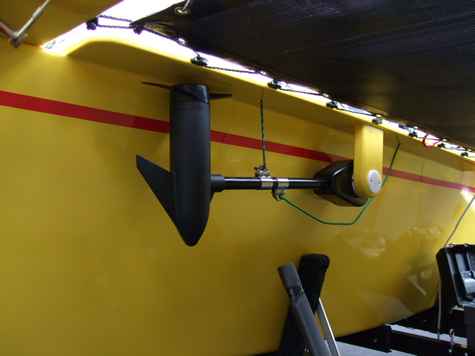
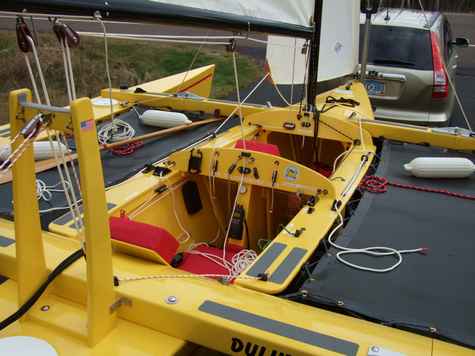
Bob Trygg
Duluth, MN
To The Freezer
One of the reasons I hate to use epoxy is that I
mix too much or too little. I just discovered a little trick that
is very convenient when I mix too much. Stick it in the freezer
asap.... before it starts to kick. If there is a small amount,
it will cool off very quickly and become so hard it is brittle.
It is then impossible to get out.... but it is brittle, so you
just whack the bottom and it will break into pieces like glass.
Pick out the piece the right size and put the rest back in the
freezer. The piece will quickly melt with the heat of you gloved
fingers. Apply to whatever and it will kick as normal. It has
lasted two weeks in the freezer and that would indicate to me
that it will last mixed a long time. The hardening must stop at
freezer temps. It hardens just as normal without any discernible
difference, the best I can tell. Does anyone see a negative?
JIB
Leeboard Traveling Support
I posted some new pics in the Jim
Michalak forum showing how I tackled the problem
of supporting the raised leeboard on my Ladybug when trailering.
This morning it occurred to me that it might be more helpful in
The Treasure Chest so here is an edited version.
Looking closely at the photos, you'll see that I have an uphaul
lanyard running from the rear of the board up through the aft
end of the upper leeboard guard & through a cam cleat. To
take much of the load off this cleat, I cut a 2"-3"
dia. circular washer from an old 3/8" thick nylon kitchen
cutting board, drilled a 6mm hole in the centre & threaded
it onto the 6mm shock cord lanyard attached to the aft end of
the top of the leeboard & cleated off (under slight tension)
in a jam cleat on the gunwale well aft of the leeboard. This shock
cord acts to hold the board down when under way, although it does
not seem to want ride up if the lanyard is left uncleated.
With the leeboard all the way up & the uphaul lanyard cleated
off in the cam cleat, I slide the nylon washer all the way forward
on the shock cord lanyard & feed it edge-on down through the
gap between leeboard & guard, that opens when I lift the board
a bit more, until the washer is sitting flat on the back of the
board. Let the board drop back down & the washer takes the
weight as the board presses it up against the underside of the
guard. It is positively located by the lanyard & can not fall
out. The board is now secured by the washer & the cleated
uphaul lanyard.
This all sounds a bit long-winded, but a close look at the photos
will tell the story. Very simple, quick & secure.
 |
 |
 |
 |
 |
 |
 |
 |
 |
Lots of pics from different angles. |
I hope this helps someone.
Allan Burke
Balance Beam and Gloves
Microsoft excel can convert fractions to decimals and back again.
Simply enter your dimension in a cell, then right click on the
cell, select "format cells". The format cells window
will pop open. Select the "number" tab at the top. To
change from a decimal to a fraction, select "fraction"
from the list at left, then the desired output on the right. Click
"OK" and you're done. To go from fractions to decimal,
choose "number" from the list at the left, then the
desired number of decimal places on the right.
Of course, that doesn't deal with feet-inches-eights layout common
in boat building, but one could input feet in one column (say
cell A1), inches in the next (say cell A2), and eigths in a third
(say cell A3) (input as a whole number, just like on the plans).
Then, cell A4 could contain the formula =((A1*12)+B1+(C1/8))*25.4
to convert it to mm.
Seth
Boat Drain Wick
Since finishing my Ladybug, I have had to leave my 11' bateau.com
GV11 dinghy right way up under a semi-porous cover, out in the
open. This cover lets a tiny amount of water through but blocks
out all the leaves & stuff that blow around & end up inside
& allows some airflow in which effectively keeps mould growth
at bay & the inside fairly clean.

The bung is left out of the drain of course to let water out,
but as most drains are set a tad above the bottom line of the
hull floor, there is always 1/2 cup or so left to get mouldy &
stain the paint.
The answer is simply to coil a short length of cord up against
the drain hole & let a few inches hang down towards the ground.
I have just used 4mm vb cord but any cord will do. This wicks
up the water & drains it overboard.

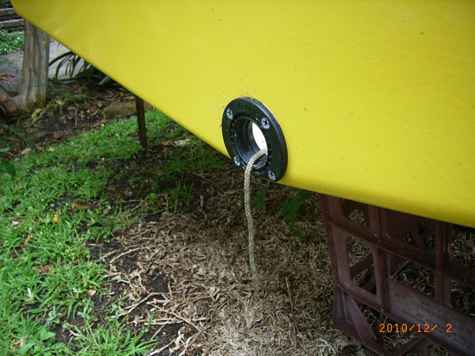

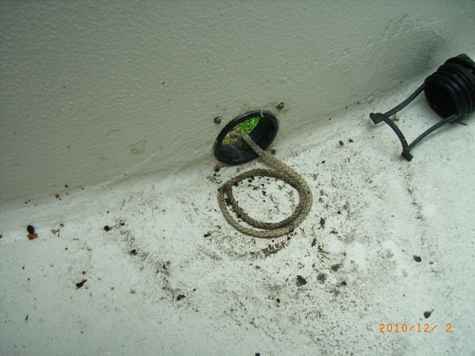
This system is good too for areas like saucers under pot plants
that tend to stay full of water & cause root rot....not a
very nautical application I suppose, but people with live-aboard
narrow canal boats & houseboats may find this handy as they
often grow all manner of plants on board.
My pics also show that I have a bit of o/b oil & grot that
I must clean up.
Al Burke
DIY Roller Furler
I just built a really nice roller furler for $40 that might be
of interest.
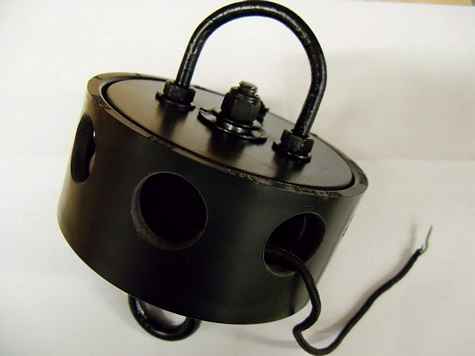
In issue
#58 of Small Craft Advisor magazine, Kirk Gresham
wrote an excellent article on how he designed and built two roller
furlers for his 17' cutter Eider for a mere $40 each using bits
of scrap and a few bits and pieces of hardware from a local hardware
store.
Months later I headed for the local Home Depot to obtain the
rest of the parts. While browsing through the plumbing department
I came across some parts that looked like they would make for
a very nice looking unit. An ABS end-cap for a 4" pipe looked
like it might be more attractive than the 1" aluminum strap
and perhaps even contain the furling line better too. I also found
an ABS pipe coupling that was wide enough to cover the two legs
of the U-Bolt, possibly making it wind more smoothly as well.
So, here
I present my slightly modified version of Kirk's
$40 roller furler.
Cheers!
Joel
For you tool freaks...
When cutting FG cloth, with the weave, I get the end of a thread
and pull it all the way out....along the line I want to cut. That
allows me to see a line and cut the cloth straight without crossing
over into other threads, wasting cloth and all the raveling that
causes. Much neater.

Click
Here to see the video.
JIB
*****
|

